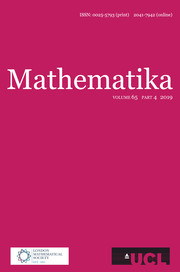Article contents
Measure function properties of the asymmetric Cauchy process
Published online by Cambridge University Press: 26 February 2010
Extract
§1. Preliminaries. A Cauchy process in d-dimensional Euclidean space, Rd, is a stochastic process, Xt(ω), with stationary independent increments and with a continuous transition density, p(t, y − x) defined by

and

where m, the isotropic measure, is a probability measure on Sd, the unit sphere in Rd, such that when d > 1 the support of m is not contained in any d − 1 dimensional subspace. In (2) w is given by

where  . It follows that for each t > 0 and y we have p(t, y) > 0 and that for each t > 0 p(t, y) is a bounded and continuous function of y. Xt(ω) can be considered as being a standard Markov process (for a full description of the definition of such a process see Chapter 1 of [1]) and in particular we can assume that the sample functions of Xt(ω) are right continuous and have left limits. We can also assume that Xt(ω) enjoys the strong Markov property. We write Px and Ex for probabilities and expectations conditional on X0(ω) = x, and we write P for P0.
. It follows that for each t > 0 and y we have p(t, y) > 0 and that for each t > 0 p(t, y) is a bounded and continuous function of y. Xt(ω) can be considered as being a standard Markov process (for a full description of the definition of such a process see Chapter 1 of [1]) and in particular we can assume that the sample functions of Xt(ω) are right continuous and have left limits. We can also assume that Xt(ω) enjoys the strong Markov property. We write Px and Ex for probabilities and expectations conditional on X0(ω) = x, and we write P for P0.
Information
- Type
- Research Article
- Information
- Copyright
- Copyright © University College London 1970
References
- 1
- Cited by

